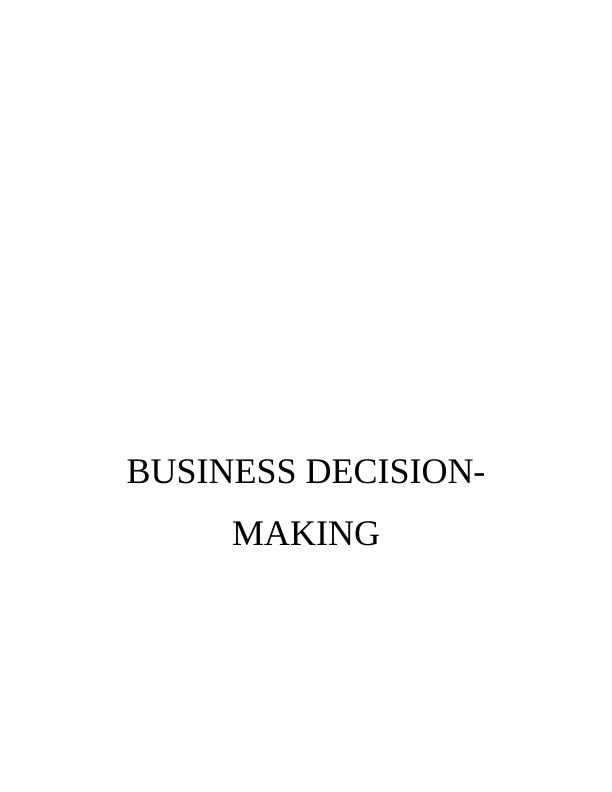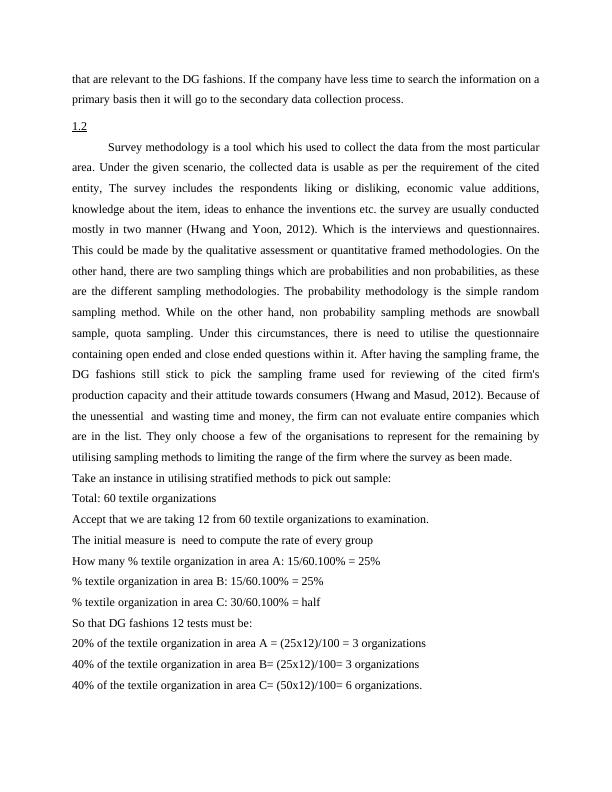Business Decision Making - DG fashions
Added on 2020-01-28
16 Pages3953 Words51 Views
BUSINESS DECISION-MAKING

Table of ContentsINTRODUCTION...........................................................................................................................3TASK.1 ...........................................................................................................................................31.1...........................................................................................................................................31.2...........................................................................................................................................41.3...........................................................................................................................................5M.1..........................................................................................................................................6TASK.2............................................................................................................................................72.1...........................................................................................................................................72.2...........................................................................................................................................72.3...........................................................................................................................................82.4...........................................................................................................................................93.1.........................................................................................................................................103.2.........................................................................................................................................113.3 COVERED IN PPT........................................................................................................11TASK.4..........................................................................................................................................114.1.........................................................................................................................................114.2.........................................................................................................................................134.3.........................................................................................................................................14CONCLUSION..............................................................................................................................15REFERENCES..............................................................................................................................16

INTRODUCTIONThis has been seen that the business decision making of the company is most crucialconcern of the firm so that the firm could attain the objectives within a time frame. There are somany tools which could affect the decisions of the firm (Kline, 2010). Decision making is thethough process which selected the logical alternatives from the available options. At the time oftaking better decisions, a person must acknowledge the positive and negative aspects of eachaspects. For making efficient decisions, an individuals is required to predict the outcomes of eachoption, and then determine the best alternative. Business decision making is a tough task whichultimately depends on the skills of the managers and top level authorities of DG fashions. TASK.11.1Data are the important tool for making any decisions which are relevant for the DGfashions. Data are statistics, explanations, versus, photographs, chart etc. mainly the data are oftwo types which is primary or secondary, and these are further categorised as quantitative andqualitative data. These are described in details:Primary data: The data which have been collated for the first time. This has been seenthat the data are collected through surveys, interviews, research or by observations. This is freshas used for the first time(Kimmel, Weygandt and Kieso, 2010.). The reliability of this data ismore as compared to the secondary one. This is the data which requires the huge resources tocollect and conduct as per the plan. This is the most successful and reliable source of datacollection, but there is a limitation of primary data gathering i.e. time consuming and muchexpensive process. Secondary data: This is the most usable data collection technique and most of the firmsare using this tool to make their business decisions viable for the attainment of the businessgoals. Now this has been seen that the data of the company is now been seen that the company isnow getting the majority of the information (Vercellis, 2011). The secondary sources arejournals, books, magazines and any other mode of informations which are already gettingpublished at somewhere. Now, DG fashions intend to search the information which are relevantto the firm and aids in making the decisions. Company's specialised SME's will filter the data

that are relevant to the DG fashions. If the company have less time to search the information on aprimary basis then it will go to the secondary data collection process.1.2Survey methodology is a tool which his used to collect the data from the most particulararea. Under the given scenario, the collected data is usable as per the requirement of the citedentity, The survey includes the respondents liking or disliking, economic value additions,knowledge about the item, ideas to enhance the inventions etc. the survey are usually conductedmostly in two manner (Hwang and Yoon, 2012). Which is the interviews and questionnaires.This could be made by the qualitative assessment or quantitative framed methodologies. On theother hand, there are two sampling things which are probabilities and non probabilities, as theseare the different sampling methodologies. The probability methodology is the simple randomsampling method. While on the other hand, non probability sampling methods are snowballsample, quota sampling. Under this circumstances, there is need to utilise the questionnairecontaining open ended and close ended questions within it. After having the sampling frame, theDG fashions still stick to pick the sampling frame used for reviewing of the cited firm'sproduction capacity and their attitude towards consumers (Hwang and Masud, 2012). Because ofthe unessential and wasting time and money, the firm can not evaluate entire companies whichare in the list. They only choose a few of the organisations to represent for the remaining byutilising sampling methods to limiting the range of the firm where the survey as been made.Take an instance in utilising stratified methods to pick out sample:Total: 60 textile organizations Accept that we are taking 12 from 60 textile organizations to examination. The initial measure is need to compute the rate of every groupHow many % textile organization in area A: 15/60.100% = 25% % textile organization in area B: 15/60.100% = 25% % textile organization in area C: 30/60.100% = half So that DG fashions 12 tests must be: 20% of the textile organization in area A = (25x12)/100 = 3 organizations 40% of the textile organization in area B= (25x12)/100= 3 organizations 40% of the textile organization in area C= (50x12)/100= 6 organizations.

End of preview
Want to access all the pages? Upload your documents or become a member.
Related Documents
Business Decision-Making Assignment: DG Fashionslg...
|25
|4259
|102
Assignment Business Decision Making Samplelg...
|41
|5733
|92
Business Decision Makinglg...
|13
|409
|318
Business Decision Makinglg...
|13
|415
|69
Business Decision Making Assignment - DG Fashionslg...
|31
|4716
|118
Business Decision Making in Blackfriars restaurant : Reportlg...
|18
|4193
|49
